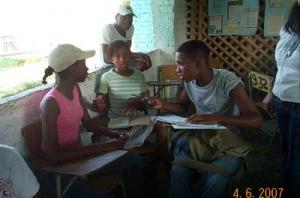
On an improvised stage “Bombón de chocolate” (Chocolate Candy) is being performed. The play, which narrates the story of an African-Colombian girl who feels rejected because of the colour of her skin, is one of the events at a special day on drug addiction and violence organised in the city of Villa Paz, in South-West Colombia. Villa Paz has a population of 4000 inhabitants, of which 54% are are women and most of whom are African descendants and whose agricultural activities are mainly related to the sugar cane.
The day’s events attended by over a thousand people began with a peace march, followed by talks on violence and health, and the projection of videos filmed on cellphones at the local telecentre.
The idea for the day arose some months earlier at a telecentre where local people discussed the community’s most pressing problems, motivated to do something about them and getting everyone involved.
But these were no ordinary discussions. For approximately eight months women and men of all ages had been getting together for workshops on gender and technology as part of piloted trials of the Gender Evaluation Methodology (GEM) in 24 government-sponsored1 telecentres throughout Colombia.
The aim was to investigate how to increase the use of telecentres by members of the community, especially women, and how these might be used to change the way both men and women saw themselves. The GEM process leads people to discuss the community’s problems beyond those of the technology. It’s all part of the “learning for change” ethos which is central to GEM.
Taking a deeper look at the community we live in
 Youth discuss during a training sessionThe idea for the action day emerged during the GEM workshops. The new telecentre users identified problems that were affecting the community in order to design an intervention. Using the telecentre as their operations base — people who had only recently sat in front of a computer for the first time, learned to send emails and write information circulars.
Youth discuss during a training sessionThe idea for the action day emerged during the GEM workshops. The new telecentre users identified problems that were affecting the community in order to design an intervention. Using the telecentre as their operations base — people who had only recently sat in front of a computer for the first time, learned to send emails and write information circulars.
A sense of community and cohesion began to take root in Villa Paz and the surrounding villages: links were established with schools, police stations and health centres.
Gender issues discussed in the open
This community commitment was an unintended (but not unexpected) outcome of GEM work carried out in the telecentre. One of the GEM goals is to sensitise the community about gender-issues.
In Villa Paz, role-playing proved to be a very successful methodology. Besides allowing people to identify the problems that affect them most, they also brought gender prejudices and stereotypes out into the open. Men and women discussed who handles the money and why, who takes decisions about children’s education, how infidelity was regarded as acceptable for men but not for women, and the double work day (on the farm and in the home) that many women endure.
“The men were very critical and some of the arguments were quite heated,” said Aura Elena Plaza, who coordinated the workshops, “but they often ended up admitting the inequality of the situations.”
Technology is empowering women
Before the application of GEM, the Villa Paz telecentre was only used by young people and children. “Some people believed that computers were a tool of the devil,” said Plaza, also a GEM facilitator in the town. “So instead we focused the offer on agricultural and manual skills training and eventually that drew people in.”
“We had to create an atmosphere of trust, because many women were trembling with fright when they sat down in front of a computer for the first time,” Plaza recalled. “Before the first workshop, all the women went to a farmhouse, without their husbands. We did physical workouts and danced, and we all talked about our home life. Some women talked about their experiences of violence. From the beginning we knew we had to boost the women’s self-esteem, and after several months’ work and a lot of patience, computers turned out to be an excellent tool,” she added.
Many new opportunities opened up for women as a result of the workshops. Marta Sandoval was one of those most afraid of computers. She was a homemaker and farmer, but recently she stood for town councillor. Now she belongs to the Grupo de Negritudes del Valle del Cauca (an Afro-descendants’ group) and is invited to take part in events all over the country. Technology set her in motion and she has obtained government grants for Villa Paz.
“The workshops helped her overcome her shyness. She was always a leader, but she lacked the tools to discover this,” said Plaza.
Selene Mezú had forbidden her children to go to the telecentre because she believed it was against her religion. Gradually she came around, taking a dressmaking course offered by a government training programme at the telecentre. She had never thought of herself as a creative person, but now she uses these skills to work professionally.
“These stories only illustrate part of the changes we have seen. Many of the women who participated in the workshops started coming forward as delegates for local organisations, and going to meetings about health issues,” said Plaza. “They are increasingly active in the public life of their community. And the evaluation has shown that this is a good thing for everyone.”
Photo by Olga Paz